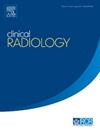超声引导衰减参数:一种预测超重/肥胖患者代谢功能障碍相关脂肪变性肝病进展的肝脏脂肪量化技术
IF 2.1
3区 医学
Q2 RADIOLOGY, NUCLEAR MEDICINE & MEDICAL IMAGING
引用次数: 0
摘要
目的探讨超声衰减参数成像(UGAP)在超重和肥胖患者代谢功能障碍相关性脂肪变性肝病(MASLD)评估中的应用价值。材料与方法在2023年8月至2024年8月期间,从XX中选取328例超重/肥胖患者,其中MASLD组225例,单纯性超重/肥胖组103例。作为典型的对照组,在同一时期选择了236名年龄和性别相匹配的健康个体。比较两组间衰减系数(AC)差异,采用Pearson相关分析探讨AC与临床指标的关系。采用独立样本t检验和多元logistic回归分析,建立预测模型,检验诊断效果,筛选超重和肥胖患者MASLD的危险因素。结果MASLD组、超重肥胖组和正常对照组的tsac分别为(0.73±0.08)、(0.57±0.04)、(0.54±0.07)dB−1·cm−1·MHz−1。两组间差异有统计学意义(P<0.05)。在超重或肥胖的患者中,AC、BMI和内脏脂肪是预测MASLD的危险因素。最佳临界值为AC≥0.635dB−1·cm−1·MHz−1,BMI≥27.58kg/m2,内脏脂肪厚度(VFT)≥66.115 mm。受试者工作特征(ROC)曲线下面积分别为0.993、0.792和0.708。AC联合BMI和内脏脂肪的ROC曲线下面积为0.997,预测效率高于单一AC指数和AC + BMI二元预测模型。诊断敏感性和特异性分别为96.4%和98.1%。结论ugap可用于临床筛查,评估超重或肥胖患者的MASLD患病率,并动态跟踪疾病进展。对于超重或肥胖的患者,通过将AC与BMI和内脏脂肪预测模型相结合,可以提高UGAP评估MASLD的准确性。本文章由计算机程序翻译,如有差异,请以英文原文为准。
Ultrasound-guided attenuation parameter: a liver fat quantification technique for forecasting the progression of metabolic dysfunction-associated steatotic liver disease in overweight/obese patients
AIM
To investigate the application value of ultrasonic attenuation parameter imaging (UGAP) in the assessment of metabolic dysfunction-associated steatotic liver disease (MASLD) in overweight and obese patients.
MATERIAL AND METHODS
A total of 328 overweight/obese patients—225 in the MASLD group and 103 in the simple overweight/obese group—were chosen from XX between August 2023 and August 2024. As the typical control group, 236 healthy individuals who were matched for age and gender were chosen during the same period. The attenuation coefficient (AC) differences between the groups were compared, and Pearson correlation analysis was used to look into the relationship between AC and clinical indicators. A prediction model was created, the diagnostic efficacy was examined, and MASLD risk factors in overweight and obese patients were screened using the independent sample T-test and multiple logistic regression analysis.
RESULTS
AC of the MASLD group, overweight and obese group, and normal control group were (0.73 ± 0.08), (0.57 ± 0.04), and (0.54 ± 0.07) dB−1·cm−1·MHz−1. There was a statistically significant difference between the groups (P<0.05). In patients who were overweight or obese, AC, BMI, and visceral fat were the risk factors for predicting MASLD. The optimal cut-off values were AC ≥0.635dB−1·cm−1·MHz−1, BMI ≥27.58kg/m2, and visceral fat thickness (VFT) ≥66.115 mm. The areas under the receiver operating characteristic (ROC) curve were 0.993, 0.792, and 0.708. The area under ROC curve of AC combined with BMI and visceral fat was 0.997, and the prediction efficiency was greater than that of the single AC index and that of the AC + BMI bivariate prediction model. The diagnostic sensitivity and specificity were 96.4% and 98.1%.
CONCLUSION
UGAP can be utilised for clinical screening to assess the prevalence of MASLD in patients who are overweight or obese and to dynamically track the progression of the disease. In patients who are overweight or obese, the accuracy of the UGAP assessment of MASLD can be increased by combining AC with BMI and a visceral fat prediction model.
求助全文
通过发布文献求助,成功后即可免费获取论文全文。
去求助
来源期刊

Clinical radiology
医学-核医学
CiteScore
4.70
自引率
3.80%
发文量
528
审稿时长
76 days
期刊介绍:
Clinical Radiology is published by Elsevier on behalf of The Royal College of Radiologists. Clinical Radiology is an International Journal bringing you original research, editorials and review articles on all aspects of diagnostic imaging, including:
• Computed tomography
• Magnetic resonance imaging
• Ultrasonography
• Digital radiology
• Interventional radiology
• Radiography
• Nuclear medicine
Papers on radiological protection, quality assurance, audit in radiology and matters relating to radiological training and education are also included. In addition, each issue contains correspondence, book reviews and notices of forthcoming events.
 求助内容:
求助内容: 应助结果提醒方式:
应助结果提醒方式:


